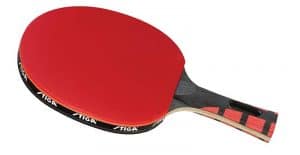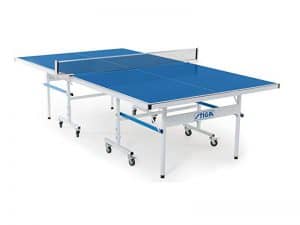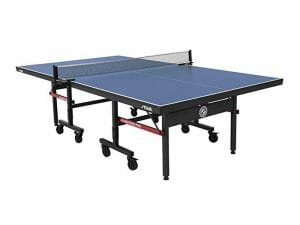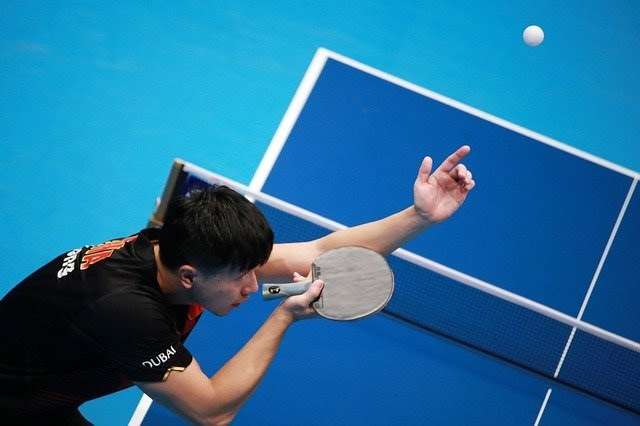Ping Pong Grips: Every Way You Can Hold a Paddle
- Eugene Sandoval
- Last updated
While you might not think it, the way you hold a ping pong paddle determines the quality of your gameplay. Mastering the mechanics of your ping pong grip improves your accuracy, control, and potential to generate spin during a game of ping pong.
There are several different types of ping pong grips that experts and coaches prefer. And each suits a specific playing style. In this guide, we’ll cover all of the different ping pong grips, listing their strengths and weaknesses, as well as how to hold your ping pong paddle for each.
Do you want more advanced coaching?
- 20+ Hours of Training
- From Beginner to Master
- Coached by Chinese National Champion
Table of Contents
Why It’s Important to Choose the Right Grip
Ping pong is a game of speed and split-second decisions, you have to train your body to respond without thinking. Your table tennis racket needs to feel like an extension of your arm — something you naturally move. Therefore your grip should feel comfortable and controllable.
For this reason, it is best to choose and train your grip early. Once you have developed poor body mechanics and bad habits it is difficult to re-train your body. When changing your grip or learning a new one, it is normal for your game to get worse at the beginning which may discourage some people and further entrench poor tendencies.
While there is no single perfect table tennis paddle grip for all players, the right grip will allow you to play to the best of your ability. So you should take care to choose correctly.
Read More: How to Make Ping Pong Paddles Sticky
Different Types of Ping Pong Grips
There are three main table tennis grips to choose from: shakehand, Chinese penhold, and Japanese penhold. Shakehand is the most popular grip of the three, especially outside of Asia. That being said, the shakehand grip is becoming increasingly common among Asian players.
As for Chinese penhold and Japanese penhold, these table tennis grips are most commonly found in Asia. They are also very similar, the only difference is how the fingers rest on the rubber.
The Shakehand Grip
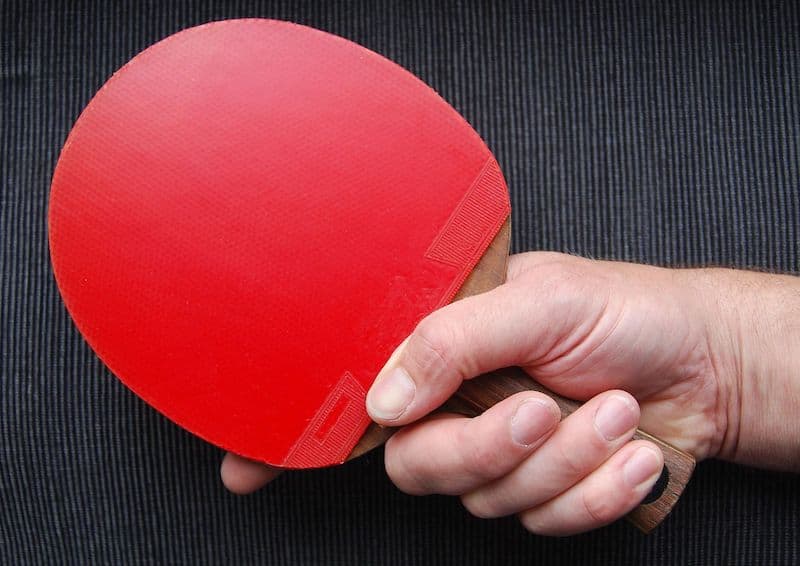
The Shakehand ping pong paddle grip got its name from the hand position which closely resembles the pose you use when shaking hands. It’s a very common grip in western countries and has gained popularity among Asian players as well. It also happens to be the best ping pong paddle grip in our opinion.
In the basic shakehand grip, you have three fingers wrapped around the handle with your index finger touching the edge of the ping pong rubber. The edge of the blade tucks into the crease between their thumb and index finger. The placement of the edge of the blade within the natural V of the hand is crucial for wrist flexibility and control.

There are two types of Shakehand grip:
The Shallow Shakehand Grip
In the shallow shakehand ping pong grip style, the hand is positioned as above, and the thumb rests lightly curled on the table tennis blade. The shallow shakehand is a natural, relaxed way to hold your ping pong paddle, and it’s easy for beginners to learn.
Pros
- Comfortable, natural feeling in the hand
- Great wrist flexibility
- Easy to micro-adjust grip
- Strong backhand and forehand
Cons
- Weak crossover point (the “crossover point” is the moment of decision when a player has to decide whether to use a forehand or backhand stroke. Delays in this decision can be crucial in a game)
- Slightly harder to use than the deep shakehand grip
I opt for the Shallow Shakehand Grip in table tennis at strategic times because it significantly enhances wrist mobility and speed, allowing for rapid, agile responses and a greater range of spin variations, crucial for outmaneuvering opponents in fast-paced rallies.
The Deep Shakehand Grip
In the deep shakehand grip ping pong holding style, the hand grabs the handle as high up as it will go. This causes the thumb to rest on the rubber as opposed to the blade. The deep shakehand grip is often recommended as a starting place for beginners.
Pros
- Comfortable, natural feeling in the hand
- Slightly more beginner-friendly
- Increased control and precision
- Strong backhand and forehand
Cons
- Weak crossover point
- Harder to micro-adjust grip
I use the Deep Shakehand Grip when I want powerful, stable strokes; it offers a firmer racket hold, enabling greater force and control in drives and loops, making it a formidable choice for an aggressive, attack-focused play style.
The Penhold Grip
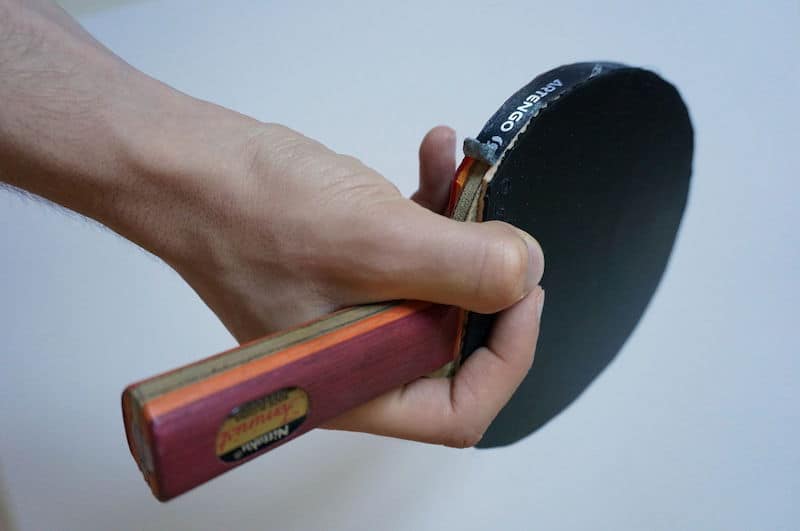
The penhold grip is so named because you hold the paddle with the handle pointing upward, and the paddle surface pointing downward. Much like you would hold a pen. It is one of the most popular grips among Asian table tennis players and is also used to some degree in the West.
In the basic penhold grip, the handle of the blade tucks into the V of the hand. The thumb and index finger wrap around the top of the handle and rest on the front rubber with the remaining fingers resting on the back rubber.
There are three types of penhold ping pong paddle holds.
The Chinese Penhold Grip
In the Chinese penhold table tennis grip style, you hold the blade downward, with the index finger and thumb wrapped around as described above. The three fingers of the hand curl gently along the rubber on the opposite side.
This a type of forehand grip, as players only use their forehand rubber. They invert their forehand 180 degrees over to the left to use it on their backhand side (for righties). This removes the issue of the crossover. However, it simultaneously has much worse backhand options than the shakehand grip.
Check out Chinese player Ma Lin to see the Chinese penhold grip in action.
Pros
- No crossover
- Super forehand
- Great wrist flexibility for imparting spin
- Effective for serving
Cons
- Difficult to impart topspin on backhand side
- Requires good footwork
The Japanese / Korean Grip Penhold Variation
In Japanese/Korean penhold, you adopt the standard penhold style and rest your three remaining fingers along the back of the paddle in a straight line rather than curling them.
Like Chinese penhold, Japanese penholders also use their forehand rubber on the backhand side. This means to use the grip effectively you need to develop good footwork so that you can play standard forehand strokes as much as possible.
Pros
- No crossover
- Great wrist flexibility for imparting spin
- Effective for serving
- Adds more power to forehand strokes, as the fingers provide more strength and stability
- More comfortable on the hands than C-pen
Cons
- Difficult to impart topspin on backhand side
- Requires good footwork
Reverse Penhold Backhand Grip
In this variation, you use the Chinese penhold grip, but instead of using an inverted forehand for the backhand, you instead use a conventional backhand. This means that the reverse penhold backhand (RPB) grip addresses the main issue of the conventional Chinese penhold grip.
As such, there’s no doubt that this is the best way to hold a ping pong paddle if you are a Chinese penholder.
One player who has really mastered this grip is Wang Hao. Check out the video below to see him in action.
Pros
- Strengthens the backhand
- Easier to initiate topspin
- Great wrist flexibility for imparting spin
- Effective for serving
Cons
- Has a crossover weakness
- Backhand is still not as strong as the shakehand grip
The Seemiller Grip
The Seemiller grip is a lesser-known about type of table tennis grip. It was popularized by five-time U.S. Men’s Singles Champion Dan Seemiller. It’s very similar to the shakehand grip. You only need to adjust your thumb and index finger so that they rest on the outer edges of the paddle.
This increases your flexibility on the forehand side of the racket allowing you to flip it 180 degrees to the left so that you can use it on your backhand side. As a result, there is no crossover weakness like the regular shakehand grip. You can also pick a tricky rubber for the other side, and occasionally switch from an inverted forehand to a regular backhand.
Pros
- No crossover
- You essentially have two backhands (inverted forehand and regular backhand)
Cons
- No ability to backhand loop
- No ability to backhand push with inverted forehand
The Pistol Grip
There’s no doubt in my mind that the pistol grip is the rarest grip in table tennis on this list. I’ve never seen a player use it in person — probably because it requires a unique custom blade. You hold the bat as if you were holding a pistol. It somewhat resembles a shakehand grip.
Pros
- Increased reach
- Opponents will be unfamiliar with the grip
Cons
- Unable to re-adjust grip
- No way to stick the rubber onto the blade without removing identifying markings
- Feels awkward to use
Read More: Basic Table Tennis Skills
Shakehand vs Penhold Comparison
| Shakehand | Penhold | |
| Forehand loop | 8/10 | 9/10 |
| Backhand loop | 7/10 | 3/10 (Reg) 5/10 (RPB) |
| Forehand flick | 5/10 | 7/10 |
| Backhand flick | 7/10 | 4/10 (REG) 6/10 (RPB) |
| Versatility | 10/10 | 6/10 |
| Main advantages | Versatile and dangerous almost everywhere | Deadly forehand |
| Main weaknesses | Crossover | Weak on backhand without RPB. Demands good footwork. |
Common Handle Styles
Straight

Straight handles have the same width from top to bottom. Some players feel that they can adjust their grip mid-rally easier with a straight handle compared with the other options.
Flared

Flared handles are the most common grip in table tennis. They are thinnest in the middle and flare out towards the end. One advantage of the flared grip is that it is easier to have a secure grasp which reduces the likelihood of your paddle flying out of your hand during a big shot.
Anatomic

These handles have a bulge just above the middle of the handle. They are thinner below said bulge and then flare out towards the end. The anatomic handle type is not very common and promotes a high grip.
Chinese Penhold

Chinese penhold handles are for penholders who use the conventional Chinese penhold or reverse penhold backhand grip. The paddle handle is short and flared. However, it is flared to a lesser extent than the flared grip.
Japanese Penhold

The Japanese penhold handle is very different from the Chinese Penhold handle despite the fact that the Japanese and Chinese penhold grips are very similar.
The Japanese penhold blade handle is much longer and thicker. So thick in fact that it creates a wide edge to rest your thumb and index finger. It’s also commonly made up of part cork to save on weight.
FAQs
What Is the Best Grip for Ping Pong?
The best grip for ping pong is the shakehand grip. It offers the best balance between backhand and forehand and only has one real weakness and that’s the crossover.
Is Shakehand Better Than Penhold?
Broadly speaking, shakehand is better than penhold. It has a much better backhand, and as such, doesn’t require elite footwork. It also performs fairly well across the board. The only area penhold possesses a distinct advantage over it is on the crossover, and this only applies to conventional penhold rather than reverse penhold backhand.
Conclusion
Now that you know the strengths and weaknesses of each ping pong grip it’s time to choose the right one for you! We know it can be a little daunting, as you don’t want to choose the wrong grip and have to make a change later. Just go with your gut.
If you’re completely undecided, we recommend opting for the shakehand grip. You simply cannot go wrong with it as it is the best ping pong grip across the board. It’s also the most dominant as we are seeing fewer and fewer top penholders each year.
Read More: Table Tennis Tips
Eugene (Gene) Sandoval has been one of those guys who spent too many hours around ping pong tables in high school. However, soon enough, Gene understood that there is more to ping pong than having fun. That is how he started a journey that made Eugene one of the experienced semi-professional ping pong players in the United States. As the founder of the PingPongRuler, Eugene spends most of his time surrounded by ping pong tables and research. He always has this knack for coming up with new ping pong strategies and telling the good and bad equipment apart.
-
Eugene Sandovalhttps://pingpongruler.com/author/admin/
-
Eugene Sandovalhttps://pingpongruler.com/author/admin/
-
Eugene Sandovalhttps://pingpongruler.com/author/admin/
-
Eugene Sandovalhttps://pingpongruler.com/author/admin/
Popular Products
Join our email list for exclusive reviews & the latest Ping Pong News
Sign up to our newsletter and stay up-to-date with the latest news in the ping pong world, and be the first to read our new product reviews. We promise, no spam






